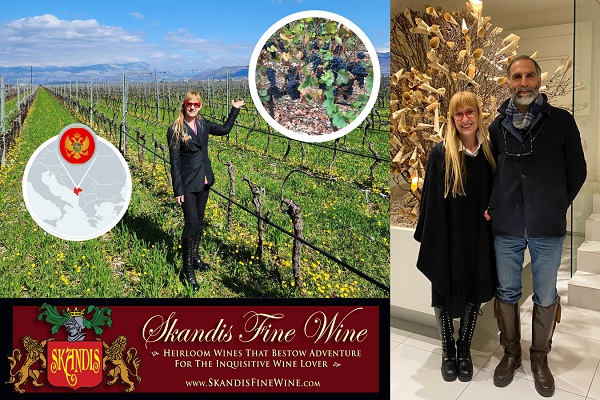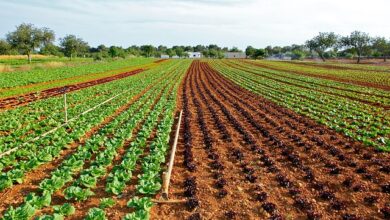
In vino (and more in ancient grape varieties) veritas/In vino (e vitigno antico più) veritas
Interview with expert Christine Skandis on new project in Montenegro/Intervista all’esperta Christine Skandis su nuovo progetto in Montenegro
On March 8, I had the pleasure of interviewing Christine Skandis, an american world expert on rare and unique grape varieties and one of the only six women inducted into the Dionysian Society International, the world’s oldest wine society because of her contributions in educating and preserving native grape varieties worldwide.
Dear Ms. Skandis, have a nice day. We know that your stay here in Milan is very short so thank you very much for your time and for this exclusive interview. I read from the wine trade press about your recent trip between Italy and Montenegro but before telling us about your new projects, I would like to ask you a little bit about yourself. How did the passion for rare grape varieties come to a business engineer, by the way, as smart as you are?
So, it is true that I graduated from the University of Michigan where I studied architecture, engineering and economics and shortly thereafter founded a successful company that provides FEA (finite element analysis) simulations for some of the most prominent companies in the United States (listed by Fortune magazine as one of the top 500), however, it is equally true that I was born and raised on a Michigan farm where I was able to develop a deep love for vegetation and its fruits. It is because of this love that over the years I have kept my roots alive and founded Skandis Fine Wines in 2001 with the goal of preserving native grape varieties that produce wines that even the most discerning consumer has sometimes never heard of.
Can you give some examples referring to Italy?
If we talk about Italy, I think of fragile grape varieties such as Erbaluce, Aglianico, Negroamaro, Nero di Troia, Falanghina, Malvasia and Bombino-just to name a few. Grape varieties that are in danger of being ripped out of the original vineyards and replaced by other better-known ones such as Chardonnay and Cabernet, for simple market reasons. And it is precisely by creating a trade market for these ancient wines in the United States that I am trying to contribute to their preservation.
What about your recent trip to Italy?
As always in my trips to Italy, there were so many beautiful things to see and so many beautiful people to meet but time is never enough! In your country I visited wineries in three different regions. In Abruzzo and Puglia I was able to catch up with old friends and visit realities unknown to me but very interesting. In Piedmont I was able to see again the small Erbaluce wineries that I have been following carefully for several years now. So, very positive experience, as always, both on a professional and human level. Same thing I could say about my first trip to Montenegro.
Right. Montenegro. How did the opportunity for this trip come about?
Nothing happens by chance. Some time ago, in fact, a well-known American but Montenegrin-born entrepreneur, the very kind Mr. Simon Palushaj, learned about my experience and passion for the preservation of indigenous grape varieties and contacted me. Having a strong attachment to his homeland and a deep knowledge of that territory and his estate vineyards, he asked me to visit them firsthand and give him my professional opinion on whether or not he could start a project to promote these wines on the world market. Driven by the heartiness and the interesting proposal, I willingly accepted.
Were you happy with the experience?
In a word? Fantastic! Both for the beauty of the natural settings I visited and the extraordinary welcome I was given and both for the uniqueness and quality of the grape varieties I visited. Never would I have thought to find so many native varieties in such a small geographic area. Fantastic!
Can you describe the value of that discovery?
Until recently, the wines produced in Montenegro were mainly intended for domestic consumption because they were processed for rustic taste profiles and not very suitable for international consumers. For some time now given the peculiarities of this territory and its grapes a certain interest has arisen. Since Montenegro is part of the southern Balkans, which were not covered by glaciers during the previous glaciation, I was able to see that there is an incredible diversity of completely unexplored plant and animal species, including 63 genotypes of indigenous grape varieties hitherto unknown to science.
What do you mean by native grape varieties?
DNA analysis to determine which plant species survived phylloxera also includes the Vranac or Krstač grape varieties. The red grape variety Vranac is one of the grapes that our international World Class Montenegro Wine Project will present. There are many varieties of Vranac – Vranac from Crmnice is different from Vranac produced in other vineyards, Krstač variants are fantastic and are one of the famous descendants of Zinfandel. Analysis of the genetic diversity of vines in Montenegro places it on the world map of wine regions as a specific and indigenous area with unique wines. The increase in the European repertoire of grape production with indigenous Montenegrin grapes has incredible significance in the field of agriculture and viticulture, as well as designating Montenegro as an interesting wine destination. Unknown to many, Montenegro has a vast number of genetically diverse indigenous grape varieties. Montenegro’s wine regions, from Crmnica to Kuče to Boka Bay and Upper Morinj, are composed of vineyards that are more than 300 years old, including the vineyard of the Monastery of St. Vasilije Ostroški, which was established in 1672.
In short, thanks to Mr. Palushaj and his love for his land, what seemed like a small project is taking on major dimensions right away.
Exactly, so much so that the project has been named by me as Montenegrin International World Class Wine and I am sure it will surely bring many new and exciting wines for lovers of this precious and ancient beverage from all over the world.
Thank you very much Ms. Skandis and see you next time!
It was a pleasure. Thanks to you.
L’8 marzo, ho avuto il piacere di intervistare l’americana Christine Skandis, esperta mondiale di vitigni rari e unici e tra le sole sei donne inserite nella Dionysian Society International, la più antica società vinicola del mondo, per il suo contributo nell’educazione e nella conservazione dei vitigni autoctoni a livello mondiale.
Gentilissima sig.ra Skandis, buona giornata. Sappiamo che la sua permanenza qui a Milano è molto breve per cui la ringrazio moltissimo per il tempo che mi dedicherà e per questa intervista in esclusiva. Ho letto dalla stampa di settore la notizia di questo suo recente viaggio tra l’Italia e il Montenegro ma prima di raccontarci dei suoi nuovi progetti, vorrei chiederle un po’ di lei. Com’è nata la passione per i vitigni rari ad un’imprenditrice ingegnera, tra l’altro molto in gamba, come lei?
Dunque, è vero che ho studiato architettura, ingegneria ed economia all’Università del Michigan e poco tempo dopo ho fondato un’azienda di successo che fornisce simulazioni FEA (di analisi degli elementi finiti) per alcune delle società più importanti degli Stati Uniti (inserite dalla rivista Fortune tra le prime 500), tuttavia, è altrettanto vero che sono nata e cresciuta in una fattoria del Michigan dove ho potuto sviluppare un profondo amore per la vegetazione e i suoi frutti. È grazie a questo amore che negli anni ho mantenuto vive le mie radici e ho fondato nel 2001 (?) la Skandis Fine Wines con l’obiettivo di preservare i vitigni autoctoni che producono vini di cui il consumatore anche più attento a volte non ha mai sentito parlare.
Può fare qualche esempio riferito all’Italia?
Se parliamo dell’Italia, penso a vitigni fragili come l’Erbaluce, l’Aglianico, il Negroamaro, il Nero di Troia, la Falanghina, la Malvasia e il Bombino – solo per citarne alcuni. Vitigni che rischiano di essere strappati dai vigneti originali e sostituiti da altri più noti come lo Chardonnay e il Cabernet, per semplici ragioni di mercato. Ed è proprio creando un mercato per questi vini antichi negli Stati Uniti che cerco di contribuire alla loro salvaguardia.
Veniamo al suo recente viaggio in Italia. Cosa ha piacere di raccontarci?
Come sempre nei miei viaggi in Italia, ci sono state tante cose bellissime da vedere e tante bellissime persone da incontrare ma poco, pochissimo tempo! Nel vostro Paese ho visitato cantine in tre regioni differenti. In Abruzzo e in Puglia ho potuto ritrovare vecchi amici e visitare realtà a me sconosciute ma molto interessanti. In Piemonte ho potuto rivedere le piccole aziende di produzione dell’Erbaluce che seguo con attenzione ormai da diversi anni. Quindi, esperienza, come sempre, molto positiva sia sul piano professionale che umano. Stessa cosa potrei dire del mio primo viaggio in Montenegro.
Giusto. Il Montenegro. Com’è nata l’opportunità di questo suo viaggio?
Nulla succede a caso. Qualche tempo fa, infatti, un noto imprenditore americano, ma nato in Montenegro, il gentilissimo signor Simon Palushaj, è venuto a conoscenza della mia esperienza e della mia passione per la conservazione dei vitigni autoctoni e mi ha contattato. Avendo un forte attaccamento per la sua terra di origine ed una profonda conoscenza di quel territorio e dei suoi vigneti di proprietà, mi ha chiesto di visitarli in prima persona e di dargli un mio parere professionale sulla possibilità o meno di poter avviare un progetto di promozione sul mercato mondiale di questi vini. Spinta dalla curiosità e dall’interessante proposta, ho accettato di buon grado.
È stata contenta di questa esperienza?
Potrei dire, entusiasta. Sia per la bellezza dei contesti naturali visitati e la straordinaria accoglienza riservatami e sia per l’unicità e la qualità dei vitigni visitati. Mai avrei pensato di trovare tante varietà autoctone in una così piccola area geografia. Fantastico!
Può descriverci il valore di tale scoperta?
Fino a poco tempo fa, i vini prodotti in Montenegro erano destinati principalmente al consumo interno perché lavorati per profili gustativi rustici e poco adatti ai consumatori internazionali. Da qualche tempo viste le peculiarità di questo territorio e delle sue uve è nato un certo interesse. Poiché il Montenegro fa parte dei Balcani meridionali, che non erano coperti dai ghiacciai durante la precedente glaciazione, ho potuto constatare che esiste un’incredibile diversità di specie vegetali e animali completamente inesplorate, tra cui 63 genotipi di vitigni autoctono finora sconosciuti alla scienza.
Cosa intente per vitigni autoctoni?
L’analisi del DNA per determinare quali specie di piante sono sopravvissute alla fillossera include anche i vitigni Vranac o Krstač. Il vitigno rosso Vranac è una delle uve che il nostro progetto internazionale World Class Montenegro Wine Project presenterà. Esistono molte varietà di Vranac – il Vranac di Crmnice è diverso dal Vranac prodotto in altri vigneti, le varianti di Krstač sono fantastiche e sono uno dei famosi discendenti dello Zinfandel. L’analisi della diversità genetica della vite in Montenegro lo colloca sulla mappa mondiale delle regioni vinicole come un’area specifica e autoctona con vini unici. L’aumento del repertorio europeo della produzione di uva con uve autoctone montenegrine ha un significato incredibile nel campo dell’agricoltura e della viticoltura, oltre a designare il Montenegro come un’interessante destinazione vinicola. Sconosciuto a molti, il Montenegro possiede un vasto numero di vitigni autoctoni geneticamente diversi. Le regioni vinicole del Montenegro, da Crmnica a Kuče, alla Baia di Boka e all’Alto Morinj, sono composte da vigneti che hanno più di 300 anni, tra cui il vigneto del Monastero di San Vasilije Ostroški, nato nel 1672.
Insomma grazie al signor Palushaj e all’amore per la sua terra quello che sembrava un piccolo progetto sta prendendo dimensioni fin da subito importanti.
Esattamente, tanto che il progetto è stato da me denominato Montenegrin International World Class Wine e sono certa che porterà sicuramente molti nuovi ed entusiasmanti vini per gli amanti di questa preziosa e antica bevanda di tutto il mondo.
Sig.ra Skandis, grazie e alla prossima!
Grazie a voi.





